
Preston Bus Station
Grade II listed
History and Future - July 2015
HIstory
Preston bus station was opened in 1969 and replaced several bus stations and street terminals around the centre. It has 80 bays and large concourses and 4 floors of car parking - each floor having 2 levels although the top floor is now closed.
In 2014 the station was sold to Lancashire County Council (LCC) for £1. In 2015 LCC have shortlisted 5 potential designs for a Youth Zone on the west concourse and a public vote has a 10% say in the outcome. See below for photos and more about the design competition.
In 2018 the Youth Zone annex to the bus station has been dropped. The station now has buses on the east side and a concourse on the west side. The south side has a new coach station area. See photos below.
Preston Bus Station is on the east side of the City Centre, the railway station is on the west side (you know it makes sense?). The bus station is next to the A59, A6 and a Holiday Inn.
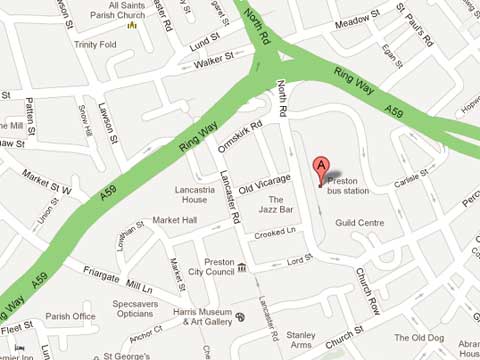
The new coach station section:
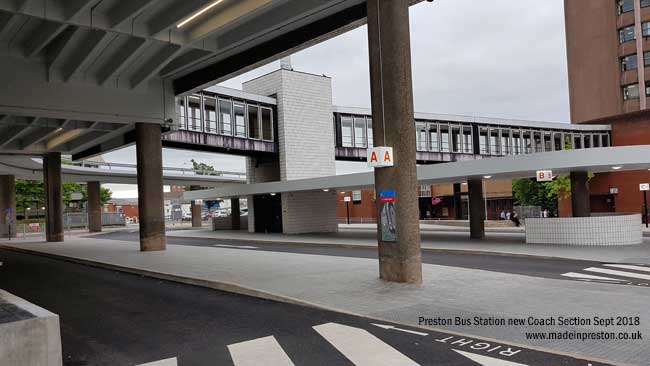
The bus stands from the inside:
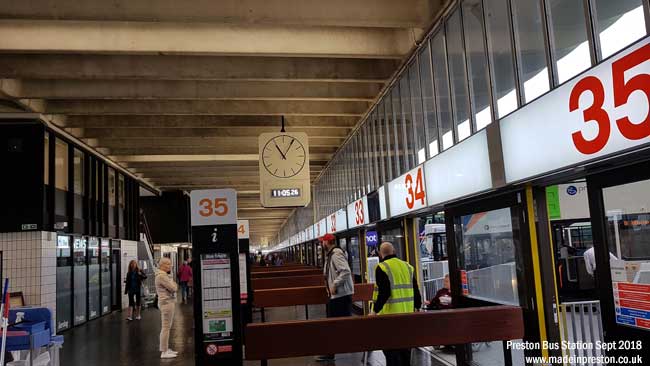
The west concourse which was going to house a Youth Zone:
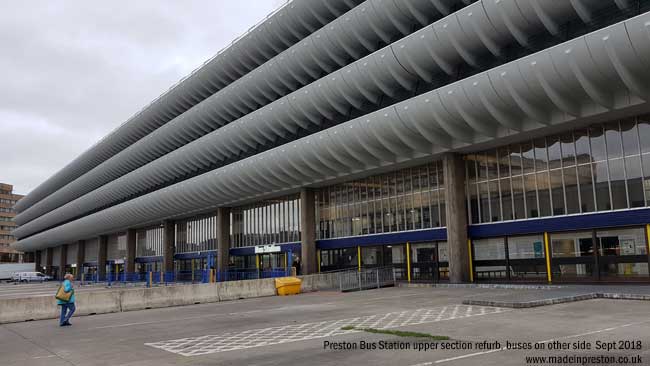
May 2012. Photo from the city centre (the west) side of the station. The zebra crossing has been added after the council gave up trying to stop people walking across the concourse.
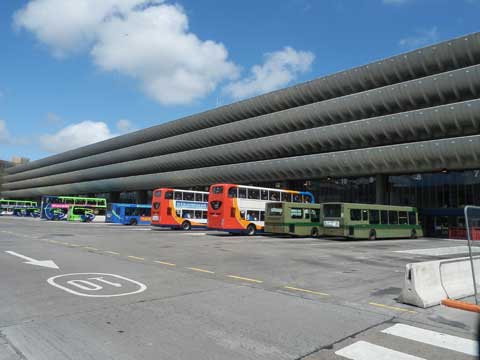
The old bus stations included Tithebarn Street bus station, the Express Bus station just across the way, Fox Street (for Fishwick), Starkey Square (for BBMS and Scout) and Corporation bus terminals around the flag market area.
Its design offered a comfortable experience where the station was approached by subways, the buses would be in fixed bays and the passengers would queue in fixed areas with a door that opened when the bus was ready to be boarded.
Some of these didn't work as advertised as bus bays were often busy so buses would park well away from their allocated spot. The passenger destination board blocked the view of the bus destination board so passengers couldn't find their buses easily. The subways became ominous places that weren't the quickest way onto the station.
The bus station was said to be the biggest in Europe and its design attracted the attention of architects. When the council wanted to knock down the bus station, every year for about 10 years, many people were up in arms and were relieved when the major Tithebarn development was shelved in 2011.
Unfortunately this threat of demolition has led to no investment and it has peeling paint and the upper floor of the car park is closed.
We use the car park and it's handy for walking under cover to the Guild Hall which is across the road from the Town Hall, Crown Court and Harris Museum and Art Gallery, Prestons other architectural gem, as well as Miller Arcade which is also a gem. There is also a subway to St John's Shopping Centre, which is there and is across from the Covered Market, which also has architectural interest being the largest unsupported Victorian roof (need to check that).
The bus station is one of Preston's major architectural features. Long may it reign!
Inside Preston Bus Station.
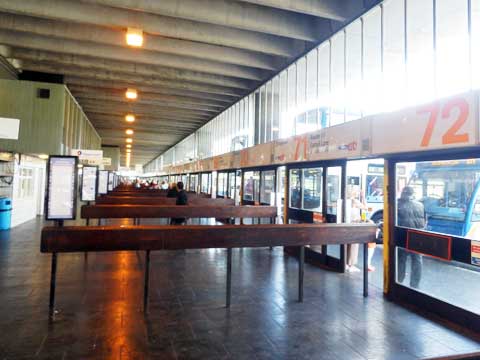
Photo from the third floor looking south east towards Bolton.
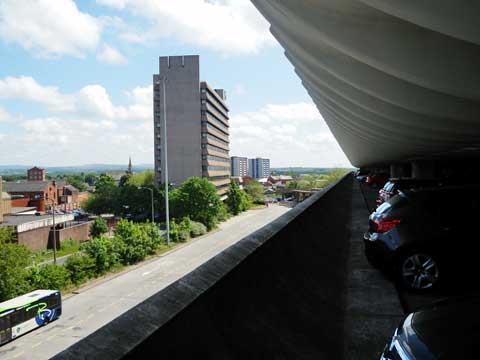
Photo from the third floor looking south west toward the City Centre: Guild Hall and Harris Museum.

Preston Bus Station Listed Grade II, 23rd September 2013
Sold to Lancashire County Council for £1 in 2014.
2015 Design Competition for Preston Bus Station
17th August 2015
It was announced that Preston Bus Station winning design is Option 5
Note that in 2018 this scheme has been cancelled.
Competition:
Introduction
INTERNATIONAL OPEN DESIGN COMPETITION
Lancashire County Council invites UK and international architects and urban designers to enter this competition for the development of the iconic grade II listed Preston Bus Station and its adjoining western apron, to include the provision of a brand new Youth Zone, a state of the art facility for the young people of Preston.
The County Council is keen to explore the opportunities this development presents to improve the connectivity from the Bus Station through to the wider City Centre thereby offering the people of Preston a new and exciting civic space, and a more attractive pedestrian route with the aim of generating a catalyst for further development within this part of the City Centre.
Further information on the aims and vision for this part of the city centre can be found in the Preston City Centre Plan
The competition will be in two phases. During the first phase the County Council will invite conceptual designs which will be judged anonymously. Following this initial evaluation 5 submissions will be shortlisted and invited to take part in phase two of the competition for which they will be awarded an honorarium. During phase two of the competition more detailed briefing information will be available and the shortlisted design teams will be asked to develop their designs further in the light of the feedback received from their phase 1 submissions and the additional information provided.
It is anticipated that the County Council will seek to retain the services of the winning consultant at least up to and including RIBA Stage 4 (subject to confirmation), and, subject to performance, probably beyond to the completion of the project. Quantity Surveying services for the project will be provided by the County Council's Design and Construction team.
In terms of the eventual contractor for the project works, they will be appointed from the County Council's own construction framework.
USEFUL DATES
Competition Launch
Wednesday, 25 February 2015
Question Deadline
Wednesday, 11 March 2015
Submission Deadline
Thursday, 30 April 2015 by 2pm
Public Vote to be submitted by 21st July, 4pm to select one of the following 5 options:
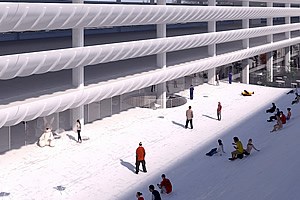 Option 1
Option 1
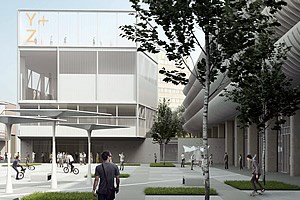 Option 2
Option 2
 Option 3
Option 3
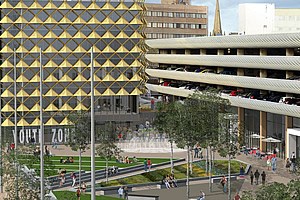 Option 4
Option 4
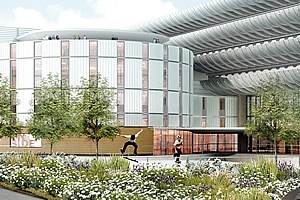 Option 5
Option 5
Site, Building, History and Context
Site
Located in the north east corner of Preston City Centre, the Bus Station sits in the heart of a 22,500 m² site. This site is situated between Tithebarn Street to the west and Carlisle Street to the east and lies just south of the main junction between the A59 and the A6. To the north and east of the site lie a mixture of a hotel, office blocks and a large retail outlet, whilst to the west there are a variety of commercial offers and an area of open space adjacent to a nineteenth century brick warehouse which is also a grade II listed building.
At the mid-point of Tithebarn Street lies St John Shopping Centre an important neighbour of the Bus Station. This retail centre is owned by Praxis Developments who are currently preparing refurbishment/redevelopment plans for it.
To the South of the site and linked to the Bus Station building via a high level footbridge as well as a pedestrian subway (an extension of the subway that serves the taxi rank) lies the Bus Station's other important neighbour the Guild Hall complex. Similar to St Johns Shopping Centre, this building is also now under relatively new ownership (The Villa Group) and again subject to significant refurbishment/redevelopment plans.
The County Council has been and will continue to work closely with Praxis and The Villa Group given the proximity of the three buildings and the strategic relationship St Johns Shopping Centre and the Guild Hall complex have with the Bus Station.
Building
The building itself consists of a 4,250 m² double height ground floor, including a 1100 m² mezzanine floor, with 9 levels of car parking above. In total the building provides for 1150 cars, however for the purposes of this design competition the 9 levels of parking and the associated access ramps are out of scope.
At the southern end of the site lies the taxi rank, a curved structure that mimics the architectural curved edges to the car park decks on the main building. This taxi rank will house the new coach station arrival and departure lanes and as such also lies out of scope for the purposes of this design competition.
The ground floor of the building is very much open plan with continuous vistas along the length of the building on both sides of the central spine of accommodation, which includes the mezzanine floor above. Both sides currently accommodate bus departure gates with the central accommodation housing a variety of commercial offers and concessions, toilets and vertical circulation which leads up to the car parking above.
Going forward only the eastern half of the building will be used for bus arrivals and departures which will free up the western half and indeed the western apron of the site for development.
The mezzanine floor houses a variety of office accommodation which currently is taken up in the main by the two bus companies that operate out of the building. It is anticipated that the structure of this central spine and mezzanine will remain intact and continue to house the current commercial demise although both being subject to refurbishment as is seen fit. As a result design proposals for the physical alteration to this central spine are not sought as part of this design competition.
History
Preston Bus Station, the largest in Europe when it was completed in 1969, was developed to provide the added services needed to serve the emergence of Central Lancashire New town in the late 1960s of which Preston would form the core.
Designed by Preston architectural practice BDP, It was also to serve the long distance services that would be made possible by the opening of the M6, the first motorway in Britain, which gave Preston a unique place in coach travel.
The design of this bus station consciously sought to offer bus passengers greatly enhanced comforts with clean modern facilities, with refreshments and heated waiting rooms separated by sliding doors from the buses outside. It was to be a bus station that overtly aspired to some of the glamour of air travel, combining rational modernity with expressive architectural forms.
Constructed in concrete the building was at the forefront of the use of GRP moulds giving a smooth finish and the compound curved surfaces which have become the predominant feature of the building.
Context
The redevelopment of this bus station will take place at a time when Preston as a whole will be seeing a number of other major redevelopment projects. Please see the plan of these developments under the supporting documentation section of this brief.
Competition Contact
The competition is being administered by RIBA Competitions, to whom any enquiries relating to the general conditions of this competition should be addressed.
Services
Revitalising Preston bus station
Background
Late 2014, the county council approved plans for a £23m refurbishment of Preston's iconic bus station. Improvements will involve the creation of a modern and vibrant public service hub, facilities for young people, bus and coach transport, and an attractive open public space, while at the same time preserving the building's unique brutalist architecture.
Improvements to the station will play a key role in helping to enable the wider regeneration and development of Preston City Centre, supporting the Preston, South Ribble and Lancashire City Deal.
The vision
Preston Youth Zone Plus
The Youth Zone Plus, will feature an indoor sports hall, an outdoor pitch, a climbing wall, fitness suite and areas for music, dance, and arts and crafts. It will occupy around a third of the ground floor space on the western side of the building, with a separate sports hall on the western apron outside.
The world class facility will provide somewhere to go, something to do, and someone to talk to, for young people from the age of 8 to 19, and up to 25 for those with disabilities and/or learning difficulties from Preston and surrounding areas.
A new bus station, coach park and multi-storey car park
A new 33 bay bus station will be created with a 4 bay coach park. The smaller bus and coach facilities would take up around half of the inside of the ground floor of the building.
The multi-storey car park above the bus station will be repaired and preserved to extend the life of the building for another 25 years.
A more attractive public space
The remaining space on the Guild Hall side will also be developed into an open public area linking to the shared space initiative currently being delivered along Fishergate.
Improved safety and access
One of the key objectives of the project is to make it easier and safer for people to access the bus station at ground floor level. This area of public space will link into Tithebarn Street, providing easier access for pedestrians visiting the city centre.
This would give us the opportunity to review the use of the three subway access points, subject to further discussion with the owners of the St John's Centre and the owners of the Guild Hall Arcade.
International competition to develop designs
The county council has launched an international architectural competition to develop designs for a new youth zone and public space on the site of Preston Bus Station.
The competition will be run by the Royal Institute of British Architects (RIBA) on behalf of the county council and launched Monday 25 February. During the first stage, anonymous design ideas are submitted based on the project brief, which has been developed by the county council, with advice and guidance from RIBA and other organisations.
To find out more about the competition visit www.ribacompetitions.com/preston
© 2015, Lancashire County Council